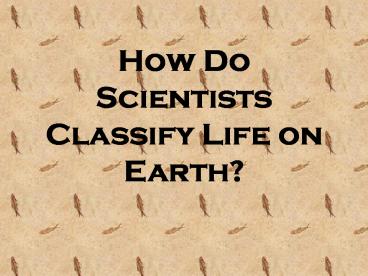How Do Scientists Classify Life on Earth? - PowerPoint PPT Presentation
Title:
How Do Scientists Classify Life on Earth?
Description:
How Do Scientists Classify Life on Earth? Bacteria Bacteria Domain Some are beneficial to humans (l. Acidohpilus) Some cause disease (e. choli) Unicellular No Nucleus ... – PowerPoint PPT presentation
Number of Views:111
Avg rating:3.0/5.0
Title: How Do Scientists Classify Life on Earth?
1
How Do Scientists Classify Life on Earth?
2
Life On Earth
- Scientists have identified approximately 2.5
million species of organisms on Earth, but
estimate that there may be as many as 10 million
inhabiting the Earth! - Of these organisms, the largest percentage are
single-celled bacteria!
3
Why Classify?
- It help us understand more about the diversity of
living things on Earth - To understand how organisms are related to one
another and how they are different from one
another.
4
Who Invented the First System for Classifying
Living Things?
- Organisms were first classified more than 2,000
years ago by - Greek philosopher Aristotle.
- He classified things as
- either Plant or Animal.
5
Aristotles System
- He grouped animals into Land Dwellers, Air
Dwellers, and Water Dwellers. - Can you think of any problems with Aristotles
system?
6
The New System taxonomy
- The discovery of new living things (thanks to
better scientific tools) has resulted in a new
classification system. - The science of classifying living things is
called taxonomy. - Scientists developed a a ranking system for
classifying organisms consisting of groups within
larger groups. - Today we will learn about Domains Kingdoms.
7
THE THREE DOMAINSAll living organisms are
organized into
- Eukarya Eukaryotes cells with a nucleus
- Bacteria Prokaryotes cells without a nucleus
- Archaea Prokaryotes cells without a nucleus
8
EUKARYA DOMAIN
- Animal Kingdom
- Plant Kingdom
- Fungi Kingdom
- Protista Kingdom
- Most organisms that we can see and that we are
familiar with are in the Eukarya Domain.
9
Archaea and Bacteria Domains
- Archaea
- Bacteria
- No nucleus (prokaryotes)
- Microscopic cells
- Adapted to life in extreme environments
- Deep ocean thermal vents
- Hot springs
- Very acidic or salty water
- Bottom of the ocean
- Petroleum deposits deep underground
- Other planets???
- No nucleus (prokaryotes)
- Microscopic cells
- Some bacteria
- are decomposers in the food chain
- are used to make food (yogurt, cheese, etc.)
- produce antibiotics
- cause disease in humans and animals
10
(No Transcript)
11
Plants
- Eukarya Domain
- Trees, grass, flowers, ferns and mosses are
examples of plants - Multicellular
- Cells have a Nucleus
- Make their own food using water, carbon dioxide,
chlorophyll and light energy - Cells have a boxy shape and contain a green
chemcial called chlorophyll
12
(No Transcript)
13
(No Transcript)
14
(No Transcript)
15
(No Transcript)
16
(No Transcript)
17
(No Transcript)
18
Animals
- Eukarya Domain
- Humans, Insects, Birds, Reptiles
- Multicellular
- Cells have a Nucleus
- Do not make their own Food
- Over 1,000,000 on the planet!
19
(No Transcript)
20
(No Transcript)
21
(No Transcript)
22
(No Transcript)
23
(No Transcript)
24
(No Transcript)
25
(No Transcript)
26
(No Transcript)
27
Fungi
- Eukarya Domain
- Yeasts, mushrooms, and molds
- Multicellular
- Have a Nucleus
- Do not make their own food- they decompose other
organisms
28
(No Transcript)
29
(No Transcript)
30
(No Transcript)
31
(No Transcript)
32
Protists
- Eukarya Domain
- Parameca and Euglena are examples
- Mostly unicellular
- Have a Nucleus
- Some can make their own food, some cant
- Microscopic but larger than bacteria
- Have different shapes
- Most are able to move
33
(No Transcript)
34
(No Transcript)
35
(No Transcript)
36
Bacteria
- Bacteria Domain
- Some are beneficial to humans (l. Acidohpilus)
- Some cause disease (e. choli)
- Unicellular
- No Nucleus
- Some can make their own food, some cant
- Microscopic
37
(No Transcript)
38
(No Transcript)































